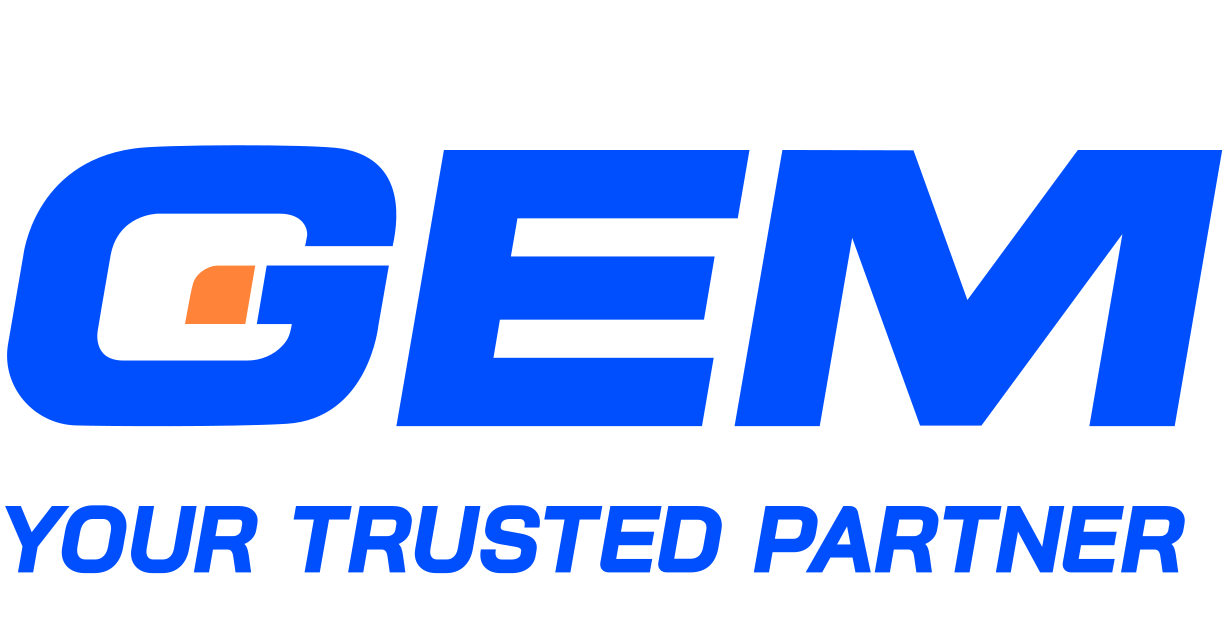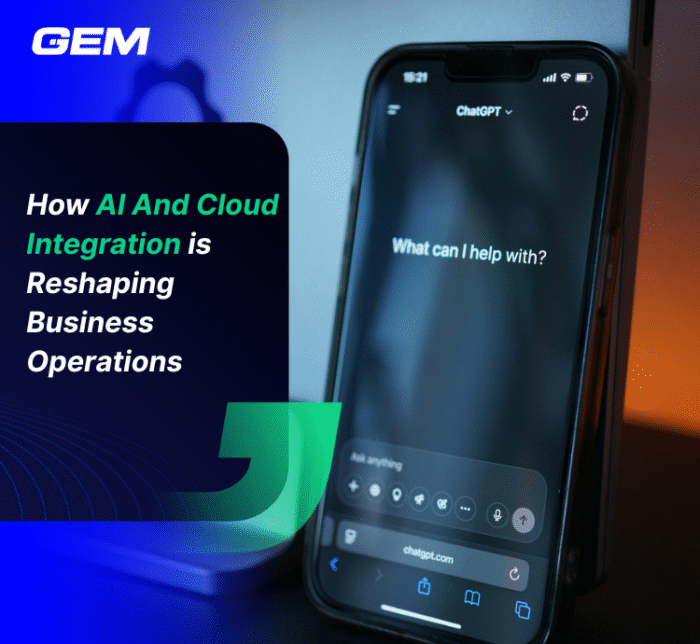Contents
- What Is Problem Management in ServiceNow?
- Problem Management Process in ServiceNow: From Detection to Resolution
- Proactive vs. Reactive Problem Management
- Common Obstacles to Effective Problem Management
- List of Problem Solving Strategies in ServiceNow
- ServiceNow Problem Solving Strategy Implementation Considerations
- Conclusion
Recurring disruptions in IT operations often stem from unresolved root causes that remain buried beneath incident backlogs. Addressing only the symptoms through Incident Management delivers short-term relief but leaves long-term risks in place. Organizations are turning to structured frameworks that focus on prevention rather than recovery. This article presents a list of problem solving strategies in ServiceNow designed specifically for Problem Management. From automated problem creation to RCA standardization and impact tracing through configuration data, each method supports a more sustainable approach to service reliability.
What Is Problem Management in ServiceNow?
Problem Management in ServiceNow is designed to address the persistent causes of service disruptions. Unlike Incident Management, which focuses on restoring service as fast as possible, Problem Management takes a methodical approach to identify what disrupted the first place and how to prevent it from recurring.
The module operates on a structured workflow. It begins with the creation of a problem record, often triggered by repeated incidents or major outages. This record becomes the anchor for deeper analysis: identifying patterns, assessing impact, and conducting root cause investigations. Teams can then define workarounds or initiate changes that eliminate the underlying issue. ServiceNow’s integration with other modules, such as CMDB, Change Management, and Incident Management, enables this process to be both traceable and scalable.
Key elements of the framework include:
- Problem Record: A formal entry that captures the description, impact, and potential root cause.
- Known Error: A documented issue with a defined workaround or permanent resolution.
- Root Cause Analysis (RCA): A structured method to trace symptoms back to their source.
- Workarounds and Fixes: Temporary or permanent measures to prevent further incidents.
Without this layer of analysis, teams risk falling into reactive cycles, fixing symptoms while the actual problem persists. Problem Management complements Incident Management, but its success depends on a distinct mindset: one that prioritizes pattern recognition, data correlation, and long-term stability over speed.
Problem Management Process in ServiceNow: From Detection to Resolution
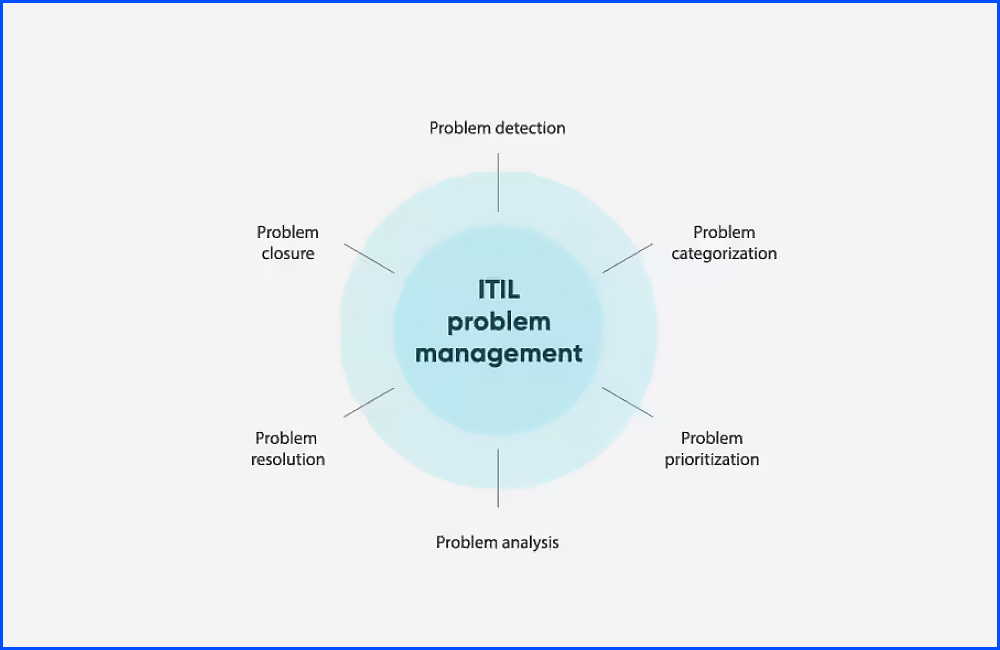
Source: Servicenow
ServiceNow’s Problem Management module provides a structured process designed to trace service disruptions back to their source and drive permanent resolution. The workflow spans several defined stages, guiding teams from early detection through to closure.
Proactive Problem Detection
The process begins with identifying potential problems before they manifest as incidents. This could involve reviewing recurring incident trends, monitoring infrastructure alerts, or analyzing known weak points in configuration data. Early detection helps teams address risks before they disrupt services.
Categorization and Prioritization
Once a problem is identified, it’s categorized based on type, impact, and urgency. This step ensures the most impactful problems receive attention first, and allows for better planning across teams. Accurate categorization also supports reporting and future trend analysis.
Investigation and Diagnosis
The next phase focuses on understanding the root cause. Technicians gather incident data, correlate system logs, and assess configuration dependencies. The goal is to define the origin of the issue and determine whether a technical or procedural change is needed.
Known Error Record Creation
If the root cause is confirmed but a full resolution is pending, a known error record can be created. This record includes details of the problem, its symptoms, and any temporary measures available. It serves as a reference point for future incidents linked to the same issue.
Workaround Documentation
In cases where resolution requires more time or coordination, a workaround may be defined. While not a permanent fix, a well-documented workaround can reduce the impact of repeated incidents and keep operations stable until the issue is fully resolved.
Problem Resolution and Closure
Closing a problem involves completing corrective action and confirming that the issue will not recur. This stage includes validating the fix, updating linked incidents, and recording lessons learned. Closure marks the transition from reactive handling to operational improvement.
Proactive vs. Reactive Problem Management
ServiceNow supports both reactive and proactive approaches to Problem Management. While each has its role, the long-term performance of IT operations often hinges on how well organisations implement the proactive side of the equation.
Reactive Problem Management begins after an incident, or a series of them, has already disrupted service. The focus is on identifying a root cause after the fact. For example, a major outage caused by a misconfigured firewall rule might trigger an investigation once it recurs across multiple environments. This approach is necessary for addressing critical failures and recurring disruptions.
Proactive Problem Management shifts the timing and the mindset. Instead of waiting for incidents, it uses historical data, trend analysis, and monitoring tools to uncover weak points before they become visible to users. This may involve:
- Analyzing high-frequency incident categories to detect underlying patterns
- Reviewing change records that repeatedly trigger user complaints
- Investigating alerts from infrastructure monitoring tools that have not yet caused visible impact
The distinction lies in intent. Reactive management asks, “What caused this outage?” Proactive management asks, “What’s likely to break next, and what can be done now to prevent it?”
Consider an organization facing frequent performance degradation in its customer portal. A reactive approach might lead to repeated fixes, restarting services, or reallocating resources. A proactive strategy would look at application logs, infrastructure dependencies, and change history to uncover a persistent memory leak or configuration bottleneck. Addressing this root issue would eliminate the symptom.
Proactive Problem Management is not about predicting every failure. It’s about building the operational discipline to investigate patterns, document known errors, and act on insights before users are impacted. ServiceNow’s platform provides the connective tissue, linking incidents, problems, and changes, to support this shift.
Read more:
Common Obstacles to Effective Problem Management
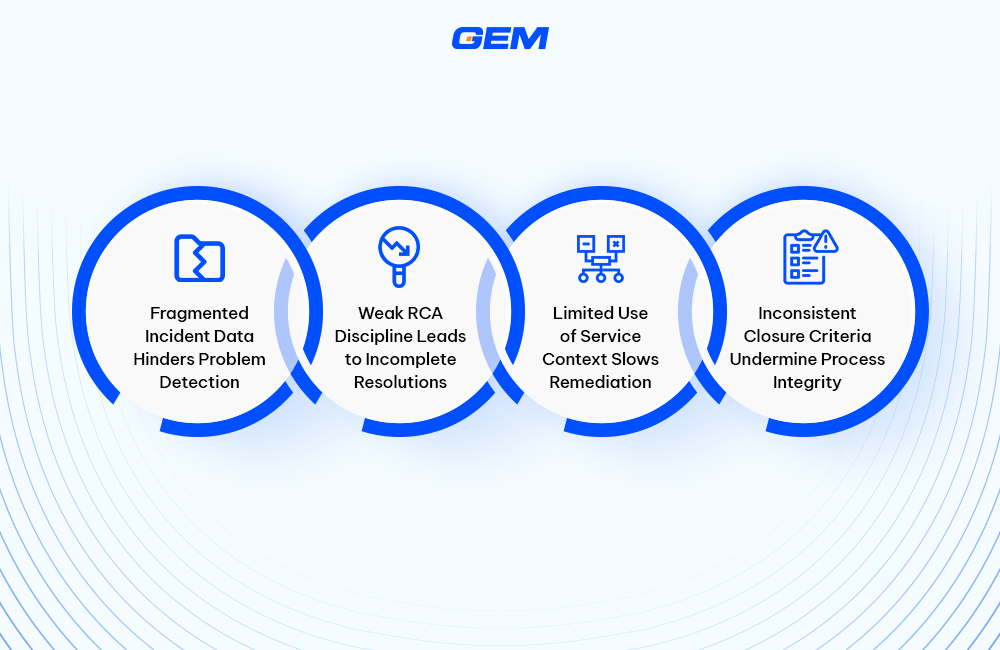
Fragmented incident data; Weak RCA Discipline; Limited use of service context; Inconsistent closure criteria
While most teams recognize the value of eliminating root causes, executing Problem Management at scale often proves difficult. The challenges are not always technical, they are frequently tied to process gaps, inconsistent data, and unclear ownership. The following are four recurring obstacles that limit the effectiveness of Problem Management programs, even within mature IT environments.
Fragmented Incident Data Hinders Problem Detection
Problem Management relies on the ability to identify patterns across incidents. When incident data is incomplete, inconsistent, or siloed across systems, potential problems remain undetected. This is especially common in environments where:
- Incident categorization is subjective or varies by resolver group
- Similar incidents are logged under different labels, making aggregation unreliable
- There is no automated process to flag repetitive occurrences
Without a unified incident taxonomy and centralized logging, teams struggle to build a reliable case for root cause investigation.
Weak RCA Discipline Leads to Incomplete Resolutions
Even when problems are identified, the quality of root cause analysis (RCA) often varies. In many cases, problem records are closed based on assumptions or workarounds, rather than verified causes.
Common breakdowns include:
- Lack of standard RCA templates or structured investigative methods
- Inconsistent documentation of contributing factors
- Limited review of historical incidents or configuration changes related to the issue
This results in superficial fixes that address symptoms temporarily but leave underlying causes unresolved.
Limited Use of Service Context Slows Remediation
Effective Problem Management depends on understanding the environment in which incidents occur. Yet many teams underutilize the Configuration Management Database (CMDB) and service mapping capabilities available within ServiceNow.
Consequences include:
- Inability to trace problems across related services or infrastructure layers
- Missed dependencies between applications, databases, and network components
- Difficulty assessing potential impact of proposed remediation actions
When the service context is missing, root cause analysis becomes slower, and remediation actions carry more risk.
Inconsistent Closure Criteria Undermine Process Integrity
Problem records are often closed without confirming that a permanent fix has been implemented or that recurrence has stopped. This weakens the value of the Problem Management function and creates a false sense of resolution.
Key issues include:
- No shared definition of what constitutes closure across teams
- Lack of linkage between problems and related changes or knowledge articles
- Absence of a peer or board-level review process to validate outcomes
Without clear closure standards, it becomes difficult to measure the effectiveness of Problem Management or build institutional knowledge.
Stop trying to find the dots. Let us help you connect them!
With GEM as your ServiceNow Partner, accelerate delivery, reduce complexity, and gain a competitive edge in today’s fast-changing market.
List of Problem Solving Strategies in ServiceNow
ServiceNow offers a set of tools that support a structured approach to Problem Management. When configured and applied effectively, these capabilities help IT teams shift from reactive incident handling to proactive root cause resolution. The following problem-solving strategies illustrate how to operationalize this shift across key areas of the platform.
Use Problem Auto Creation from Incidents
Repeated incidents are often the earliest signal of an underlying problem. ServiceNow allows teams to set rules that automatically generate problem records when incident patterns emerge.
- Define criteria such as frequency, category, or affected service to trigger auto-creation
- Route the generated problems to the appropriate resolver groups without manual intervention
- Use automation policies to reduce time spent identifying candidates for root cause analysis
This approach reduces dependency on human detection and accelerates the transition from incident to investigation.
Apply RCA Templates and Knowledge-Centered Practices
Root Cause Analysis (RCA) is most effective when it follows a consistent and repeatable structure. ServiceNow supports standardized RCA templates that guide teams through the investigation process.
- Tailor templates to reflect business-specific investigative methods (e.g., 5 Whys, Fishbone)
- Capture interim findings, contributing factors, and confirmed causes in a structured format
- Publish validated resolutions as knowledge articles for future reuse
Embedding RCA into the knowledge lifecycle builds institutional memory and improves the quality of future resolutions.
Read more:
Leverage CMDB and Service Mapping for Impact Tracing
Understanding the technical environment is critical to identifying how and where a problem originated. ServiceNow’s Configuration Management Database (CMDB) and Service Mapping tools provide that operational context.
- Use relationship data from the CMDB to identify affected infrastructure and services
- Analyze upstream and downstream dependencies to trace fault propagation
- Prioritize remediation based on service criticality and user impact
Linking problems to configuration items improves diagnostic accuracy and supports risk-aware resolution planning.
Trend Analysis Using Performance Analytics
Problems are often embedded in long-term patterns that are not visible on a ticket-by-ticket basis. Performance Analytics enables teams to identify these hidden trends before they escalate into larger disruptions.
- Build dashboards to track incident volume by category, business unit, or service
- Monitor recurring issues over time using trend indicators and historical baselines
- Set alerts when thresholds are crossed, prompting proactive investigation
This data-driven approach turns historical noise into predictive insight.
Integrate Change and Problem Workflows
Problem resolution often requires a structural fix, which can involve configuration or code changes. ServiceNow allows seamless linkage between problem tickets and the Change Management module.
- Tie remediation actions directly to Change Requests and track implementation status
- Require verification of fix effectiveness before closing the problem record
- Maintain audit trails to validate that problems are resolved, not just deferred
This alignment ensures that problems are closed only after verified, and permanent action is taken.
Establish a Problem Review Board
Governance is a key part of making Problem Management sustainable. A recurring review process helps validate RCA quality and monitors the follow-through of corrective actions.
- Form a cross-functional board to review high-impact or unresolved problems
- Use review sessions to assess RCA depth, fix reliability, and recurrence metrics
- Document learnings and update RCA practices based on board feedback
The review board approach reinforces accountability and improves process maturity over time.
Each of these problem solving strategies supports a structured, preventive model of IT operations. When applied together, they help organizations shift from reactive service recovery to proactive resilience.
ServiceNow Problem Solving Strategy Implementation Considerations
Implementing ServiceNow-based Problem Management strategies requires more than just activating features. Success depends on aligning data architecture, operational governance, and process automation with the unique needs of the organization.
Data model consistency (CSDM alignment)
A consistent, reliable data structure is the foundation of effective Problem Management. Aligning with the Common Service Data Model (CSDM) allows teams to link problems to the right services, infrastructure components, and business functions. This alignment ensures that root cause analysis is not performed in isolation but in the context of real service dependencies. Without CSDM compliance, incident trends may go unrecognized, and remediation efforts risk being misdirected.
Integrating problem workflows into a CSDM-aligned architecture also supports accurate reporting, automated routing, and downstream change tracking – key for organizations operating at scale.
Governance and ownership of problem records
Establishing ownership is not just about assigning tasks – it’s about defining accountability throughout the problem lifecycle. Effective governance requires clarity on who investigates root causes, who validates fixes, and who approves closure. In many organizations, the absence of documented policies leads to stalled problem records, redundant investigations, or premature closures without verification.
Implementing service-level targets for RCA completion, along with cross-functional review mechanisms, helps maintain momentum and visibility. Governance frameworks also provide the structure needed to enforce quality standards across different business units or resolver groups.
Automation in detecting and routing problems
Automation acts as a force multiplier in environments where incident volumes are high and manual triage is unsustainable. Within ServiceNow, automated rules can detect incident patterns, trigger the creation of problem records, and assign them based on service ownership or impact criteria.
Predictive intelligence features can also suggest likely root causes or flag anomalies before they escalate. This reduces dependency on human pattern recognition and accelerates the response timeline. When configured properly, automation not only improves efficiency but also increases consistency in how problems are identified and managed.
Specialized partners in accelerating configuration and adoption

Even with the right tools in place, many organizations face challenges in configuring ServiceNow to reflect their operational realities. This is where specialized partners play a critical role.
GEM Corporation is a certified ServiceNow partner with over 11 years of experience delivering enterprise IT solutions across industries. Our team brings deep platform expertise and operational insight to design, deploy, and scale ServiceNow modules, including Problem Management, Incident, Change, ITSM, ITAM, ITOM, etc. Our approach is not one-size-fits-all. We work closely with client teams to configure workflows, automate routing logic, and establish governance policies that work within their organizational constraints. As a ServiceNow partner, we bring proven delivery capability and platform fluency, helping enterprises translate ServiceNow’s capabilities into measurable outcomes at scale.
Conclusion
Effective Problem Management in ServiceNow depends on consistency, governance, and applied platform capabilities. The list of problem solving strategies in ServiceNow, such as automated problem creation, structured RCA templates, CMDB-based impact tracing, and more, offers a foundation for proactive operations. Execution requires aligned data models, accountable ownership of problem records, and selective automation. Organizations working with experienced ServiceNow partners like GEM gain the benefit of tailored configuration and operational alignment across modules. With disciplined implementation, IT teams can transition to a structured approach that supports reliability, minimizes repeat incidents, and strengthens service continuity.
To explore how these strategies can be configured for your environment, CONTACT US for a focused conversation!
How does ServiceNow support both proactive and reactive problem management?
The platform enables reactive problem management through incident correlation and major incident review workflows. For proactive efforts, it offers trend analysis, performance data, and integration with monitoring tools, allowing teams to detect risks before users are impacted.
What are the common challenges teams face when adopting problem management in ServiceNow?
Key obstacles include lack of alignment between incident and problem records, inconsistent root cause documentation, and limited stakeholder engagement. Many teams also struggle to shift from reactive patterns to structured, forward-looking analysis.
Which strategies help operationalize problem solving within the platform?
Effective strategies include linking incidents to problems through automation, using the CMDB to trace configuration dependencies, and creating known error records with documented workarounds. These actions convert raw data into actionable insights and improve response consistency.
What should teams consider before implementing problem management strategies in ServiceNow?
Teams should review current workflows, define ownership models, and ensure data quality across incident and change modules. A phased approach, starting with clear use cases and measurable goals, tends to yield stronger adoption and operational value.
